|
JANUARY 2022
|
|
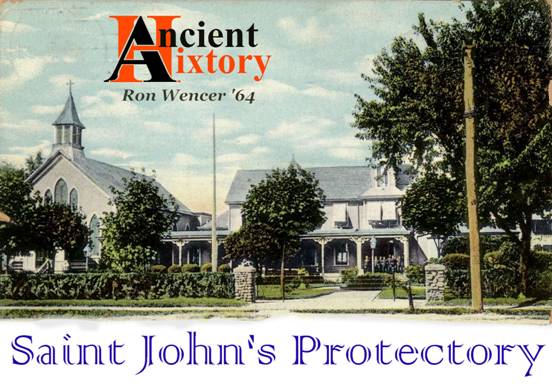
|
|
In the past, readers of Hixnews have written
in about
St. John's
Protectory a number of times.
This month, AH
attempts to provide a more complete version of its history,
gleaned from contemporary reports and news articles.
|
Introduction: A "Protectory?"
They could have called it something else.
In fact, they might have called it many things - orphanage,
work house, poor house, refuge, even
reformatory.
Although it was a little bit of each, none of those labels really
fit. Many of the boys housed
in the Protectory were not orphans.
Some came from families which through illness or poverty simply
could no longer take care of them. Others
had been removed by social agencies from abusive or dysfunctional
households. Some had been
placed in the Protectory by the courts, in the hopes that the petty
criminal behavior often shown by streetwise boys might be redirected
positively. At least one
poor family persuaded their son to commit petty theft and be caught,
hoping that he would be sent there and find a door to a better life.
Most people may have thought of it as an orphanage, but "protectory"
fit it much better.
Antecedents
|

|
|
St. John's
Home for Boys, Brooklyn, NY, c1909
Brooklyn
Public Library Digital Collections
|
The
Roman Catholic Orphan Asylum Society of Brooklyn was established in the 1830s.
By the 1890s, the Society's old
Saint John's
Orphan Asylum for Boys in
Crown
Heights
had grown, but with more than 900 young residents, once again it was at
capacity. For reasons
similar to those just discussed, it had been renamed simply St.
John's Home for Boys.
Similarly, the Society's flagship facility in
Queens
was by then called St. Joseph's
Home for Girls. Somewhat
smaller, it still could house well over 600 children.
|
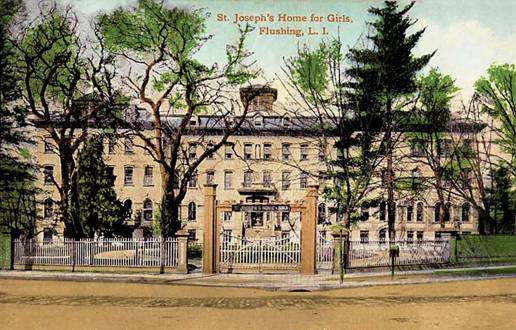
|
|
St.
Joseph's Home for Girls, Flushing, NY, c1910
flickr.com
|
|
***
|
Bernard Earle
In
1885, Bernard Earle, a wealthy retired builder who had moved to
Hicksville
some years earlier, donated to the Orphan
Asylum Society his home on "the
Jericho Road
," along with the 107 acres of farmland on which it stood.
The gift was contingent upon the Society's establishing on the
property a satellite facility of St. John's Home for Boys, and also upon the Society's calling it
St. John's
Protectory.
Already well-known in
New York
as a philanthropist, especially with respect to Catholic causes, Earle
apparently remained a businessman at heart.
From time to time, public notices in the
New York
newspapers continued to announce foreclosure actions which the kind
philanthropist had initiated against his debtors.
Although
renovation and construction were still in progress on the site, the
first boys took up residence there in 1890.
A year later, this progress report from the Society provided a
good summary of what had been done:
|
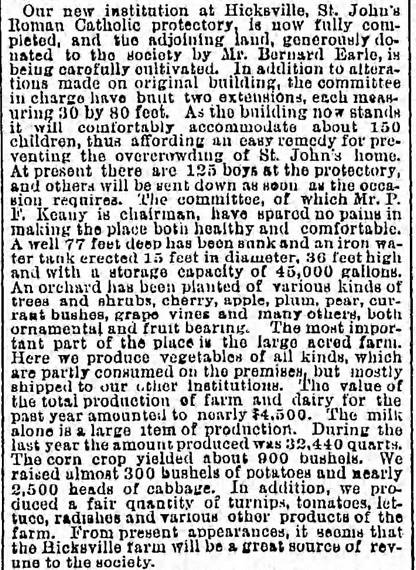
|
|
The
Brooklyn
Daily Eagle, April 12, 1891
|
The
most obvious change to the property was yet to come: the construction of
a chapel adjacent to the home, which was formally dedicated to Saint
Bernard in 1896.
|
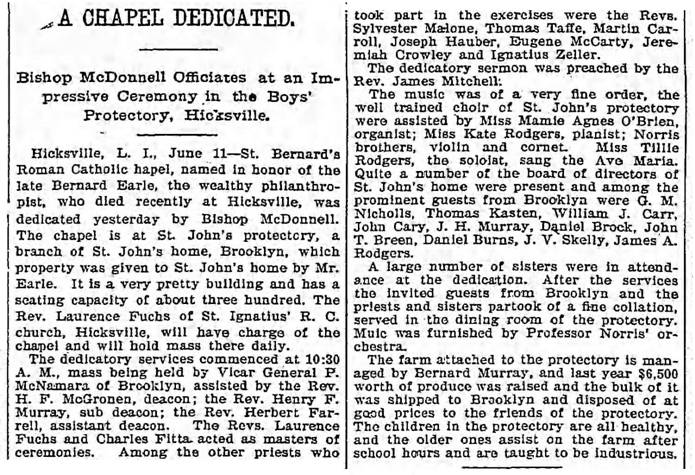
|
|
The
Brooklyn
Daily Eagle, June 11, 1896
|
Note:
The Appendix to this article features a news story from 1895, which
describes the Chapel in detail, and also adds some interesting notes
about the operation of the Protectory.
Protectory Life
The annual reports of the Orphan
Asylum Society, read in combination with contemporary news stories,
give us some inkling of life within the Protectory's walls.
The facility's capacity was usually given as 125 boys.
Nuns were the core of the administration and educational staff;
other positions, from choir director to farmhand, seem to have been held
by men. The total number of
adults on hand cannot be known from the annual reports of the Society,
which lump together staffing figures for Brooklyn and
Hicksville
. As one would expect,
schooling, farm work, and career training constituted the greater part
of the boys' routines. The
farm's annual gross revenue seems impressive - $4,500 in 1892, as an
example - but the annual expense of educating, housing, clothing, and
feeding more than 100 boys also must have been impressive.
Career training was taken seriously - at the time the annual
report was prepared, a number of boys had been sent to
Ohio
to learn "fancy glass making" from manufacturers.
Health was a concern.
By the 1890s, the world was acquiring a better understanding of
how diseases spread. The
Society decided that its larger residences, which housed hundreds of
children, should have "quarantine rooms," in which sick children
could be isolated before their illness spread.
Putting the new rooms in the most crowded facilities may have
made a difference: there was a polio epidemic in the summer of 1916, but
not one of the 1,700 children in the Society's facilities contracted
the disease.
Quarantine rooms seem not to have been fitted into the Protectory, a
non-decision which later may have proved significant.
The global influenza of 1918-1919 was more highly contagious than
polio, and at one point, at least half the boys in the Protectory, as
well as a number of the adults on staff, were simultaneously ill with
the "Spanish flu." The
newspapers reported no deaths among the boys (which does not necessarily
mean that none of them died), but one nun, the well-liked Sister
Bernadine, did die of influenza. She
had had spent a quarter century - her entire career of service as a
nun - at the Protectory.
On the day of her Requiem Mass at St. Ignatius, townsfolk respectfully
gathered along the route to view the cortege that bore her remains south
to the church from the home. Clearly,
the village did not consider those at the Protectory to be outsiders.
|
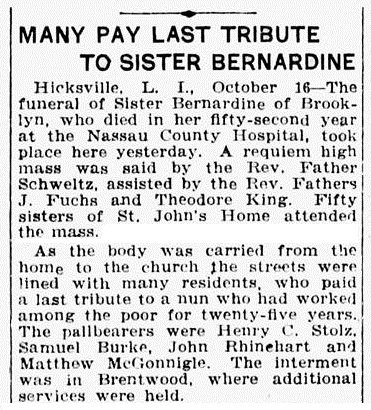
|
|
Excerpt
of article from
The
Brooklyn
Daily Eagle, October 16, 1918
|
|
***
|
From a Boys' Perspective
Boys, especially older ones, got to venture
"beyond the fences" with some frequency.
Perhaps the most common reason was so that they could march in
the village's regular parades. During
the Great War, the Liberty Bond drives involved parades, social
activities, and displays of military vehicles and weapons, all of which
most boys would have found interesting.
The 1919 Independence Day parade and homecoming celebrations for
those who served in uniform would have been exceptionally memorable.
Although the number of boys at the Protectory was
small, it was able to field sports teams that competed against teams
from other organizations or schools.
Its choir and chorus often performed at public events, as did its
band. A high note (yes,
that's a pun) occurred in 1934, when the Protectory Band was invited
to play in the parade that celebrated
Brooklyn
's Tercentenary.
Perhaps the best outing a boy might have all year
happened on Thanksgiving Day - and not for the reasons you might
guess.
If we could look back a century or more, to some past Thanksgiving, and
see the streets of some American town or city, we might think that we
were witnessing a Hallowe'en. Costumed
children (then called "ragamuffins") would be running through the
streets, stopping passers-by and ringing doorbells, holding out their
hands, and saying "Anything for Thanksgiving?"
With luck, they'd get a candy or cookie in response.
With better luck, they'd get a penny or two.
|
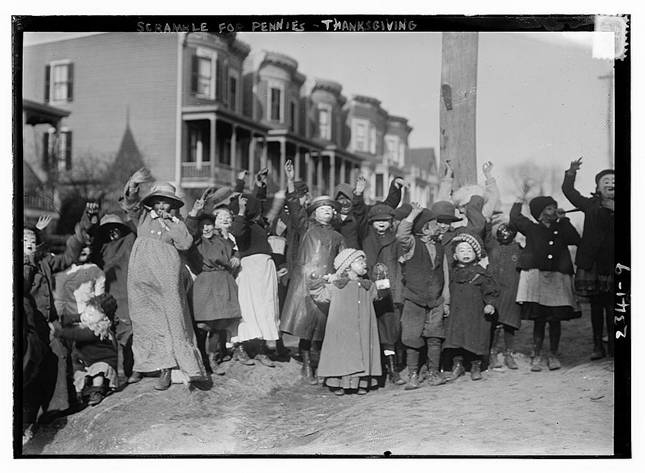
|
|
Looking
like a nightmare directed by Federico Fellini, ragamuffins in
an unidentified early twentieth century American town compete
for
attention, hoping that some pennies will be thrown their way.
Bain
News Service, Publisher.
Scramble for pennies - Thanksgiving. [Between and Ca. 1915]
Photograph.
Retrieved from the Library of Congress, <www.loc.gov/item/2014689991/>.
|
It all goes back to the story which Americans
associate with the first Thanksgiving.
Had it not been for the good will and generosity of strangers -
the native Americans - the Pilgrims would not have survived their
first winter in
America
. Thanksgiving is a way of
celebrating and re-creating that selfless kindness.
Somewhere along the line, however, by the nineteenth century, American
popular culture had tapped into the legends of the Elizabethan era, when
bands of beggars, singing rowdily and playing music, would arrive at a
town one day and half-intimidate the locals into giving them alms (which
they often did, just to get the beggars to leave town as soon as
possible). Ragamuffins
originally were children dressed to look like beggars, wearing
ill-fitting worn old clothes, and deliberately smudged with coal dust to
look dirty (the homemade masks and more fanciful costumes came later).
They'd start Thanksgiving Day by assembling in some designated
spot, and then "march" in what was called the Ragamuffin
Guards or the Ragamuffin
Parade. Serenading the
public was optional.
On the day after an especially good Thanksgiving for the Protectory
boys, newspaper readers saw the following:
|

|
|
Wow,
that means that there were more than
enough celery stalks
to go around. Yippee!
Excerpts
from the
Huntington
Long-Islander, November 27, 1914
|
|
*
|
Obviously, Christmas at the Protectory was always a
high point
. The newspaper report of
the 1903 holiday informs us that the arrangements had been made by
Sister Superior Adelaide and her five assistants.
The day began in the Chapel at 7:00 AM, when Father Fuchs
celebrated Mass, at which the boys' choir sang, with the professional
choir master singing solos. The
meal began at 11:30 AM, and after a suitable interval, the boys' gifts
("useful articles, books, candies, nuts, and fruit") were
distributed. Christmas trees
stood in two public spaces, each tree bedecked with ornaments made by
the boys.
Prior to Christmas, the boys had been visited by H.B. Fullerton,* who
had spoken to them about new scientific advances in agriculture.
*
Fullerton
was in charge of the LIRR's Demonstration Farm, created to expose Long
Islanders to improved farming methods.
He also worked personally with President Roosevelt to find ways
of improving the nation's food supply.
June of every year meant a graduation ceremony.
With fewer than 125 boys of school age, the graduating class size
was small, and the ceremony would have been very personal and emotional
for all. Speeches were made,
the chorus sang, prayers were offered, and the graduates received
academic, athletic, and other awards, as well as their diplomas.
At some point, the Protectory introduced the idea of allocating to each
older boy a personal garden plot, 20' x 20' in size.
This allowed the boys to compete with each other, and thereafter,
gardening prizes for their plots also were awarded to boys upon
graduation.
Home or Stalag?
Life cannot always be all sweetness and light.
If it were, there would be no need for a Protectory.
One likes to believe that most of the boys who lived at the
Protectory understood that life there was better than any alternative
open to them - but for some of the boys, life there was never
going to be as they wanted.
The facility had only been open for a matter of
months when four youngsters ran away, allegedly because they had been
cruelly forced to work long hours. They
also claimed to have been jailed in a communal cell with "tramps,"
after seeking refuge at a church. Their
allegations were published - and then shown to be lies.
Three of the boys were too young to be assigned work at the farm,
and admitted they had lied. The
fourth had run away before, and been returned, but also had not been
assigned any work. The four
had been confined in a clean room, not a cell, by themselves while they
awaited transportation back to the Protectory.
The newspaper printed the correct account once it was known.
How one felt about residing at the Protectory likely depended on why one
was there. For example, the
two teens who were sent there for stealing 50 pounds of lead pipe
probably regarded it as a prison. The
impoverished woman who was willing to pay the very significant sum of
$10 to someone who promised to get her son (already convicted of grand
larceny) into the Protectory (by having him commit a petty crime!)
probably saw the home as his last chance to learn how to live honestly.
The public may have been made hyper-aware of such
cases. The police certainly
were. In one case, the press
was informed that police records showed a young man recently arrested
for burglary had previously "spent a term in the Catholic Protectory,"
and was still "on parole." One imagines that honest graduates who
were making their way through life sometimes encountered the stigma
generated by mistaken understandings of the Protectory.
The End Came Quietly
In 1937, the Protectory closed, all its boys having been transferred to
the
Brooklyn
home. The complex was
abandoned, presumably only after the Chapel was deconsecrated, and any
critical items were removed from the buildings.
I have found nothing online about the reasoning that led to the
closing of the Protectory in 1937. Were
there no pandemic, I would fly to
New York
, and examine the final records of The
Roman Catholic Orphan Asylum Society of
Brooklyn
. They are held in the Center
for Brooklyn History collection at the
Brooklyn
Public Library.
One can, however, speculate with some confidence.
The prolonged Great Depression still lingered.
The previously independent Asylum
Society was effectively dissolved by merging it into the Diocesan
Charities of the Diocese of Brooklyn.
The timing of this change suggests that the Diocese was doing
what it could to respond to the economic pressures of the day.
Before the Depression hit, the Society's facilities had always
depended on donations - regular small donations from many, many
people, and extraordinary large ones from the wealthy.
But jobs and fortunes alike were lost in the 1930s, and the
Society's donations all but evaporated.
Continuing on its own would have been impossible for the Society.
Political and legal forces may also have been at
work. It may have been
easier for the Brooklyn Diocese to keep all its facilities within its
territory. One can also
speculate that
Nassau
County
would have been unwilling to assume any implicit responsibility for 125
needy Brooklyn boys who could be equally needy in
Brooklyn
.
In any case, the Protectory closed, and rather
quietly. I have not yet
found any news articles about the closure, or about the fate of the nuns
who had served there. I
imagine that a great many people mourned its passing, and I cannot
honestly believe that
Hicksville
was in any way better off without it.
Appendix
|
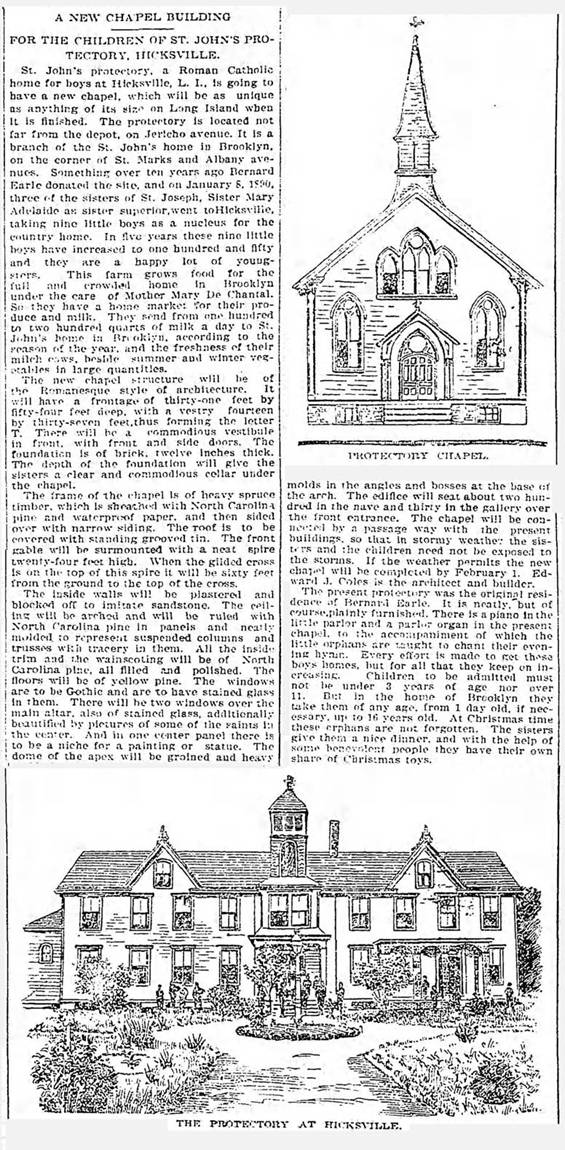
|
|
Compare
the drawing above with the postcard image included
at the start of this article, which shows the veranda and
other modifications made to the original Earle house.
The
Brooklyn
Eagle, December 22, 1895
|
|
*****
|
'Bye
for Now!
|








